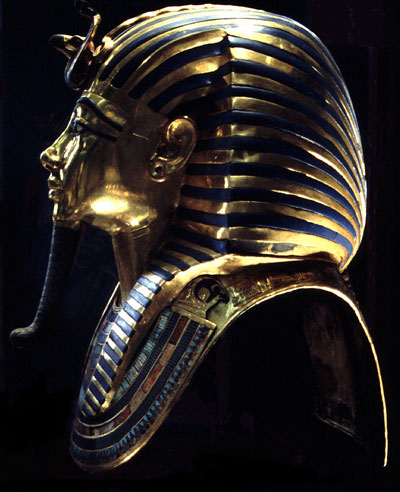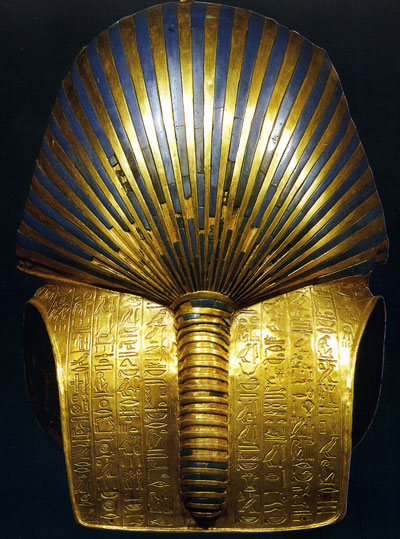Tutankhamun's Gold Mask
Tutankhamun's gold death mask is probably the most famous artefact ever found in Egypt. Howard Carter described it as: 'a beautiful and unique specimen of ancient portraiture', which 'bears a sad but calm expression suggestive of youth prematurely overtaken by death.'
The mask is a marvel of skilled craftsmanship. Weighing 10kg, it was beaten from sheet gold and inlaid with coloured glass and semi-precious stones. The stripes on the headdress are glass, but the eyeliner and eyebrows are of lapis lazuli, one of the Egyptians' favourite stones, which had to be imported from Afghanistan. The eyes themselves are of obsidian (black volcanic glass) and quartz.
Tutankhamun wears on his forehead two goddesses - Nekhbet, the vulture goddess of Upper Egypt, and Wadjet, the cobra goddess of Lower Egypt - protecting him, and showing that he is ruler of both kingdoms. On his chin is the false beard worn by pharaohs on important occasions.
Over his shoulders Tutankhamun wears a collar, of lapis lazuli, quartz and green feldspar, with a lotus-bud border. On each end are falcon heads, representing Horus, god of pharaohs.
The holes in the ears show that Tutankhamun, like many young Egyptian boys, wore earrings. By adulthood he would have stopped wearing them.
Below we can see the mask from the side and the back. On the back we get a good sense of how the nemes headdress was brought together to cover a ponytail. Below is a hieroglyphic inscription, a magic spell which says:
"...Your right eye is the night boat [of the sun god], your left eye is the day boat, your eyebrows are [those of] the Ennead of the Gods, your forehead is [that of] Anubis, the nape of your neck is [that of] Horus, your locks of hair are [those of] Ptah-Soker. [You are] in front of the Osiris [Tutankhamun], he sees thanks to you, you guide him to the goodly ways, you smite for him the confederates of Seth so that he may overthrow your enemies before the Ennead of the Gods in the great Castle of the Prince, which is in Heliopolis...the Osiris, the king of Upper Egypt Nebkheperura, deceased, given life like Ra."



Very few gold masks of pharaohs or other royals have been found, because nearly all Egyptian tombs and their treasures were robbed long ago. However, here we can see the gold mask of the pharaohs Psusennes I, who lived about 300 years after Tutankhamun in Tanis, a city in the north of Egypt. The tomb was discovered by egyptologist Pierre Montet in 1940.
This mask is mainly gold, with some lapis lazuli and black and white quartz. Psusennes bears a gold cobra on his forehead. In many wall paintings and statues, pharaohs are shown with the cobra goddess but not the vulture goddess, which we do see on Tutankhamun's mask.
Psusennes is shown wearing the nemes headdress, the false beard, and a collar. The collar is engraved to show flower buds and lotus flowers at the bottom.
